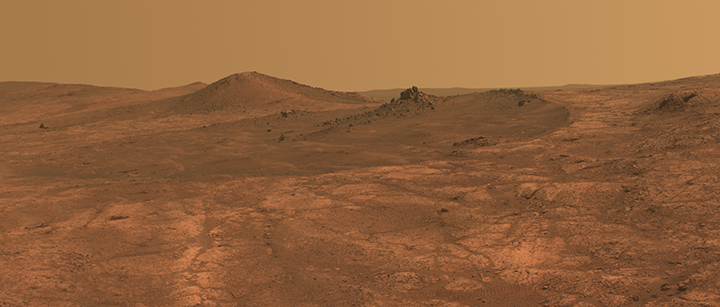- Home
- > Outreach
- > Publications
- > CONVERGENCE
- > Featured Topics
 Featured Topics
Featured Topics
Mission to Mars
- Is Mars migration possible? -
Forty-eight years have passed since humans first set foot on the moon. Now that the exploration of Mars by unmanned rovers is possible, the expression "colonization of Mars" is no longer considered “out of this world”. Thinking from the perspective of cutting-edge planetary science, life science, and material science - is actual migration to Mars possible? We spoke to Director Kei Hirose and Associate PI Tomohiro Usui of the Earth-Life Science Institute at Tokyo Institute of Technology (ELSI) about their prospects and technology required for the future.
Is the day we stand on Mars soon?

− Mars immigration is a hot topic these days.
Hirose: NASA seems to be thinking about how we can really move to Mars, and Elon Musk of Space X is hard at work as well. A nonprofit organization in the Netherlands called Mars One has also begun recruiting hopeful migrants. Even people from the private sector are planning and working at this; it’s not a sci-fi movie. Interest in Mars is rising at a global level, and I think we’re at the stage where the roadmap is being made.
Usui: NASA alone is not enough to provide human and other resources for really learning about Mars, so we’re working in an international framework. We’re working at investigating meteorites from Mars (※1), and sending probes (※2) there to discover more. There are still plenty of knowledge gaps between us and migration, or even manned flights to Mars.
− With the current roadmap, when will immigration begin?
Hirose: If things go well, NASA plans a manned flight to Mars in 2035. Another quarter century for migration? Of course, I don’t think this plan will work so smoothly (laughs).
− Then why do you and ELSI focus on Mars?
Hirose: One main reason we study Mars is to compare it to Earth. Mars and Earth are made by basically similar processes. Mars may have been a blue planet just like Earth. It’s estimated that three hundred million years ago, 20% of Mars’ surface was covered with ocean. It’s also believed that, at that time, Mars had a high temperature core and thermal convection producing a magnetic field like that of Earth.
− Nothing like the Mars we know now.
Hirose: It is thought that a series of small meteors fell on Mars from 4.2 to 3.9 billion years ago, ultimately cooling the liquid core and causing the thermal convection to stop, setting the magnetic field like a permanent magnet. Without a magnetosphere, the solar wind (plasma particle gas) stripped the planet's atmosphere, and the water evaporated. The water molecules were ionized by radiation, hydrogen gas was released into space, and oxygen oxidized everything on the surface. The soil is covered with iron oxide, and this is the red surface of Mars.
− There is a possibility that Mars was once like the Earth, and the possibility that Earth was once like Mars is currently.
Hirose: Different processes between Earth and Mars lead them to different results as planets. Based on the knowledge we have, it's very interesting to consider if there was life on Mars at that time. Under the hypothesis that life was born on the Earth, if we apply that idea to Mars in that same period, we reach a conclusion that is verifiable. The fact that we can verify models made on Earth is one of Mars' interesting points.
− Mars is called the brother planet of Earth.
Usui: To me, Mars is more interesting than the Moon or Venus due to its rich geological diversity; volcanic topographies, traces of river flow, ancient ocean sediments, and glaciers in polar caps. There are also four seasons. Since the beginning of the 2010s, we have been able to estimate the amount of water vapor in the atmosphere using the telescopes at the Mauna Kea observatories. We are finally beginning to understand how the atmosphere moves on Mars.
Hirose: NASA seems to be thinking about how we can really move to Mars, and Elon Musk of Space X is hard at work as well. A nonprofit organization in the Netherlands called Mars One has also begun recruiting hopeful migrants. Even people from the private sector are planning and working at this; it’s not a sci-fi movie. Interest in Mars is rising at a global level, and I think we’re at the stage where the roadmap is being made.
Usui: NASA alone is not enough to provide human and other resources for really learning about Mars, so we’re working in an international framework. We’re working at investigating meteorites from Mars (※1), and sending probes (※2) there to discover more. There are still plenty of knowledge gaps between us and migration, or even manned flights to Mars.
− With the current roadmap, when will immigration begin?
Hirose: If things go well, NASA plans a manned flight to Mars in 2035. Another quarter century for migration? Of course, I don’t think this plan will work so smoothly (laughs).
− Then why do you and ELSI focus on Mars?
Hirose: One main reason we study Mars is to compare it to Earth. Mars and Earth are made by basically similar processes. Mars may have been a blue planet just like Earth. It’s estimated that three hundred million years ago, 20% of Mars’ surface was covered with ocean. It’s also believed that, at that time, Mars had a high temperature core and thermal convection producing a magnetic field like that of Earth.
− Nothing like the Mars we know now.
Hirose: It is thought that a series of small meteors fell on Mars from 4.2 to 3.9 billion years ago, ultimately cooling the liquid core and causing the thermal convection to stop, setting the magnetic field like a permanent magnet. Without a magnetosphere, the solar wind (plasma particle gas) stripped the planet's atmosphere, and the water evaporated. The water molecules were ionized by radiation, hydrogen gas was released into space, and oxygen oxidized everything on the surface. The soil is covered with iron oxide, and this is the red surface of Mars.
− There is a possibility that Mars was once like the Earth, and the possibility that Earth was once like Mars is currently.
Hirose: Different processes between Earth and Mars lead them to different results as planets. Based on the knowledge we have, it's very interesting to consider if there was life on Mars at that time. Under the hypothesis that life was born on the Earth, if we apply that idea to Mars in that same period, we reach a conclusion that is verifiable. The fact that we can verify models made on Earth is one of Mars' interesting points.
− Mars is called the brother planet of Earth.
Usui: To me, Mars is more interesting than the Moon or Venus due to its rich geological diversity; volcanic topographies, traces of river flow, ancient ocean sediments, and glaciers in polar caps. There are also four seasons. Since the beginning of the 2010s, we have been able to estimate the amount of water vapor in the atmosphere using the telescopes at the Mauna Kea observatories. We are finally beginning to understand how the atmosphere moves on Mars.
To build a home on Mars

− Then, if we attain such a roadmap, what sort of lifestyle can we expect when mankind arrives to live on Mars? For example, how should we consider places to inhabit?
Hirose: It will be very difficult to live on the surface of Mars. It's impossible for human beings and other normal life forms to survive there due to high oxidation on the surface.
− There are also problems of radiation and ultraviolet rays.
Hirose: On the other hand, there are also some interesting stories. The interior of Mars is far from oxidative. Rather, it is said to be more reductive than Earth. So, it might be a good idea to dig a hole for living spaces. What I have heard is that Mars has cavities called lava tubes that can form after lava flows. Mt. Fuji in Japan also has underground caves; such dwellings may be a good start for the beginning phase.
− Let’s say we can find such lava tubes. In order to make it a good place to live, we'll need some building materials. Will Mars provide the necessary structural and functional materials?
Hirose: Cement, representative of structural materials, should be easily obtainable. First of all, as a representative of structural materials, I think that cement is probably available. Raw limestone is abundant there; of course it may have been oxidized, but it can be deoxidized. The real problem might be obtaining metal.
− Could we get iron, for example?
Hirose: Iron is common in Mars' ore deposits, but iron and steel manufacturing will be necessary. On Earth, we melt iron ore in a blast furnace to remove the oxygen.
Usui: Stones like those of Hawaii, though rusted, cover the surface of Mars. As to the question of whether the same materials can be produced as they are on Earth, the answer is YES. However, even if we stood on the lava in Hawaii, we're unable to retrieve iron ores there. In Earth's case, iron ores are created by water circulation and element concentration by biosis. Then iron ores form a vein, and then we can extract mineral resources from it. First, we need to find a vein.
Hirose: As there are traces where the river flowed, there should be a coalesced vein just like on Earth. It just hasn't been found yet.
Usui: Compared with Mars, Earth had overwhelmingly large activity in the agglomeration process and its timespan was long. There were some places with salt water flow, but not many. However, several places where hot water once circulated have been found, and I’ve heard that opals and concentrated heavy metals exist there.
Hirose: In the case that we want copper and to use Martian minerals, even if we find a vein we will still have to extract from Martian stone. We'd melt them on Earth, but it would be difficult on Mars. One idea being considered is a method called bioleaching, which is carried out by microorganisms such as bacteria. It is a method of conducting precipitation and dissolution by metal complex formation via the microbial redox process. There is already a copper leaching method using sulfate reducing bacteria. We could use this method on Mars. There are also cases that iron and phosphorus were extracted by using bacteria from simulated Martian soil.
− What about the atmosphere?
Hirose: The Martian atmosphere is very thin and 95% is carbon dioxide. Despite the thin atmosphere, there is more carbon dioxide than Earth. If humans are to live there, we need to consider that there is almost no water vapor and nearly no oxygen.
− We need to bring oxygen from somewhere or make it.
Hirose: Since the surface of the Mars is very oxidized, decomposing it and taking oxygen out is a reasonable way. There is the idea of making microorganisms do it, or via electrolysis.
− Do we need to bring microorganisms or bacteria that have such a function?
Hirose: Of course. Well, if you say that all microorganisms are just made of genes, in due time we may be able to synthesize DNA all over there. But, that's difficult in current synthetic biology, right?
− If there's a module similar to a kind of microorganism, is it the best? WPI-MANA has ideas about artificial photosynthesis.
Hirose: It could be. It will be easier to control. After all, no matter how useful microbes are, it doesn’t mean that they do what we want them to do. Devices that humans can control properly will be more useful than microorganisms. Seems to be more energy efficient.
Hirose: It will be very difficult to live on the surface of Mars. It's impossible for human beings and other normal life forms to survive there due to high oxidation on the surface.
− There are also problems of radiation and ultraviolet rays.
Hirose: On the other hand, there are also some interesting stories. The interior of Mars is far from oxidative. Rather, it is said to be more reductive than Earth. So, it might be a good idea to dig a hole for living spaces. What I have heard is that Mars has cavities called lava tubes that can form after lava flows. Mt. Fuji in Japan also has underground caves; such dwellings may be a good start for the beginning phase.
− Let’s say we can find such lava tubes. In order to make it a good place to live, we'll need some building materials. Will Mars provide the necessary structural and functional materials?
Hirose: Cement, representative of structural materials, should be easily obtainable. First of all, as a representative of structural materials, I think that cement is probably available. Raw limestone is abundant there; of course it may have been oxidized, but it can be deoxidized. The real problem might be obtaining metal.
− Could we get iron, for example?
Hirose: Iron is common in Mars' ore deposits, but iron and steel manufacturing will be necessary. On Earth, we melt iron ore in a blast furnace to remove the oxygen.
Usui: Stones like those of Hawaii, though rusted, cover the surface of Mars. As to the question of whether the same materials can be produced as they are on Earth, the answer is YES. However, even if we stood on the lava in Hawaii, we're unable to retrieve iron ores there. In Earth's case, iron ores are created by water circulation and element concentration by biosis. Then iron ores form a vein, and then we can extract mineral resources from it. First, we need to find a vein.
Hirose: As there are traces where the river flowed, there should be a coalesced vein just like on Earth. It just hasn't been found yet.
Usui: Compared with Mars, Earth had overwhelmingly large activity in the agglomeration process and its timespan was long. There were some places with salt water flow, but not many. However, several places where hot water once circulated have been found, and I’ve heard that opals and concentrated heavy metals exist there.
Hirose: In the case that we want copper and to use Martian minerals, even if we find a vein we will still have to extract from Martian stone. We'd melt them on Earth, but it would be difficult on Mars. One idea being considered is a method called bioleaching, which is carried out by microorganisms such as bacteria. It is a method of conducting precipitation and dissolution by metal complex formation via the microbial redox process. There is already a copper leaching method using sulfate reducing bacteria. We could use this method on Mars. There are also cases that iron and phosphorus were extracted by using bacteria from simulated Martian soil.
− What about the atmosphere?
Hirose: The Martian atmosphere is very thin and 95% is carbon dioxide. Despite the thin atmosphere, there is more carbon dioxide than Earth. If humans are to live there, we need to consider that there is almost no water vapor and nearly no oxygen.
− We need to bring oxygen from somewhere or make it.
Hirose: Since the surface of the Mars is very oxidized, decomposing it and taking oxygen out is a reasonable way. There is the idea of making microorganisms do it, or via electrolysis.
− Do we need to bring microorganisms or bacteria that have such a function?
Hirose: Of course. Well, if you say that all microorganisms are just made of genes, in due time we may be able to synthesize DNA all over there. But, that's difficult in current synthetic biology, right?
− If there's a module similar to a kind of microorganism, is it the best? WPI-MANA has ideas about artificial photosynthesis.
Hirose: It could be. It will be easier to control. After all, no matter how useful microbes are, it doesn’t mean that they do what we want them to do. Devices that humans can control properly will be more useful than microorganisms. Seems to be more energy efficient.
Water and Energy Sources
− So, we've worked out the location. We get a certain level of atmosphere. What's next?
Hirose: Energy. It is very far from the Sun, so the average temperature is 60 degrees Celsius below zero. The average temperature of Earth is about 15 degrees Celsius. It is an extremely cold place. A nuclear battery, not a solar cell, is installed into a Mars rover. NASA also has a project to make a small nuclear reactor on Mars. We must bring such energy sources from Earth, or find it on Mars.
− It is said that water exists on Mars.
Hirose: Basically, it's expected that a lot of frozen layers exist in various places if you dig a little.
Usui: A large amount of ice has not been found, but there are electrical geophysical data that a frozen layer, dozens of meters thick, exists beneath a wide area. There is a big technical jump to actually dig up the ground, but we can access the ice if we know the location of the shallow frozen layer. Places seeping water on the surface were commonly found. In the warm equatorial crater slope, black stains cyclically appear in the summer and disappear in the winter. Looking at the spot spectroscopically, it seems that the salt water evaporates little by little and disappears in the winter time. I believe that such a seasonal cycle is very important for life activities.
Hirose: Energy. It is very far from the Sun, so the average temperature is 60 degrees Celsius below zero. The average temperature of Earth is about 15 degrees Celsius. It is an extremely cold place. A nuclear battery, not a solar cell, is installed into a Mars rover. NASA also has a project to make a small nuclear reactor on Mars. We must bring such energy sources from Earth, or find it on Mars.
− It is said that water exists on Mars.
Hirose: Basically, it's expected that a lot of frozen layers exist in various places if you dig a little.
Usui: A large amount of ice has not been found, but there are electrical geophysical data that a frozen layer, dozens of meters thick, exists beneath a wide area. There is a big technical jump to actually dig up the ground, but we can access the ice if we know the location of the shallow frozen layer. Places seeping water on the surface were commonly found. In the warm equatorial crater slope, black stains cyclically appear in the summer and disappear in the winter. Looking at the spot spectroscopically, it seems that the salt water evaporates little by little and disappears in the winter time. I believe that such a seasonal cycle is very important for life activities.
Mars and the Search for Life

− For the previously mentioned bioleaching and such, we'll have to bring a lot of fungi or microorganisms from Earth to create the environment.
Hirose: From the perspective of scientists seeking the origin of life, it's no fun to bring them from Earth (laughs). If a life form was born on Mars, it must be a life different from the one on Earth. Put crudely, every single life on Earth is all the same. Although Earth seems to have a rich diversity of animals, it is possible to say that they all have only one principle.
− What's called the "central dogma" (※3).
Hirose: That's right. To know the diversity of life, we want to know about life that is not from Earth.
− Does that mean that there is a possibility that Earth life will be destroyed if sent to Mars as an alien species?
Hirose: I said that there is only one kind of life on Earth, but there might have been about 100 kinds of life in the beginning. I believe that it is highly possible that our ancestors destroyed other lives and became the last survivors. Can we do the same thing on Mars? Thinking about the origin of life, I am very concerned.
− If the current DNA and RNA life forms are the only type of life on the Earth, there is a possibility that other planets have quite different forms of life.
Hirose: It could be. That is exactly what we want to know the most.
− That is the fundamental question of ELSI.
Hirose: We often talk about life in the universe, but life in the universe and the life on Earth cannot be the same. I don’t think that they have the same central dogma. The Earth must have its unique character, and life exists on it in tune with the environment. We don’t know the difference from others. That is the most interesting for me.
− There is the possibility that there are creatures we cannot imagine.
Hirose: Of course there is. We use 20 amino acids in our body. Let’s say that we could use 25 of them. What we can do with them is very interesting question. Instead, how about narrowing it down to 15? The number 20 is definitely not a fixed number. It is also very interesting to see what happens when we get 25 different kinds of animo acids. It cannot be the same.
− From the perspective of life research, studying about Mars and other planets is important.
Hirose: It is important to explore Mars to know whether or not any life exists on it, but our main interest is to see how Martian life differs from Earth life.
− One final question. If you could go to Mars in the future, would you want to go?
Hirose: Well, it's not so appealing to me (laughs). I don’t wish to live on the reddish ground over there. I'll be observing it from Earth (laughs).
※1:As of September 2017, 198 meteorites from Mars were discovered.
※2:Eight rovers have been sent to Mars since the Mars Pathfinder succeeded in landing for the first time in 1997. NASA's Curiosity rover is in operation and sends images of Mars to Earth.
※3:An idea from molecular biology that all creatures on the Earth have the same principle. DNA becomes proteins through RNA, and the series of information transfers to create organism structures or functions can be applied from bacteria to humans and plants. Introduced by the late Dr. Francis Crick in 1958.
Hirose: From the perspective of scientists seeking the origin of life, it's no fun to bring them from Earth (laughs). If a life form was born on Mars, it must be a life different from the one on Earth. Put crudely, every single life on Earth is all the same. Although Earth seems to have a rich diversity of animals, it is possible to say that they all have only one principle.
− What's called the "central dogma" (※3).
Hirose: That's right. To know the diversity of life, we want to know about life that is not from Earth.
− Does that mean that there is a possibility that Earth life will be destroyed if sent to Mars as an alien species?
Hirose: I said that there is only one kind of life on Earth, but there might have been about 100 kinds of life in the beginning. I believe that it is highly possible that our ancestors destroyed other lives and became the last survivors. Can we do the same thing on Mars? Thinking about the origin of life, I am very concerned.
− If the current DNA and RNA life forms are the only type of life on the Earth, there is a possibility that other planets have quite different forms of life.
Hirose: It could be. That is exactly what we want to know the most.
− That is the fundamental question of ELSI.
Hirose: We often talk about life in the universe, but life in the universe and the life on Earth cannot be the same. I don’t think that they have the same central dogma. The Earth must have its unique character, and life exists on it in tune with the environment. We don’t know the difference from others. That is the most interesting for me.
− There is the possibility that there are creatures we cannot imagine.
Hirose: Of course there is. We use 20 amino acids in our body. Let’s say that we could use 25 of them. What we can do with them is very interesting question. Instead, how about narrowing it down to 15? The number 20 is definitely not a fixed number. It is also very interesting to see what happens when we get 25 different kinds of animo acids. It cannot be the same.
− From the perspective of life research, studying about Mars and other planets is important.
Hirose: It is important to explore Mars to know whether or not any life exists on it, but our main interest is to see how Martian life differs from Earth life.
− One final question. If you could go to Mars in the future, would you want to go?
Hirose: Well, it's not so appealing to me (laughs). I don’t wish to live on the reddish ground over there. I'll be observing it from Earth (laughs).
※1:As of September 2017, 198 meteorites from Mars were discovered.
※2:Eight rovers have been sent to Mars since the Mars Pathfinder succeeded in landing for the first time in 1997. NASA's Curiosity rover is in operation and sends images of Mars to Earth.
※3:An idea from molecular biology that all creatures on the Earth have the same principle. DNA becomes proteins through RNA, and the series of information transfers to create organism structures or functions can be applied from bacteria to humans and plants. Introduced by the late Dr. Francis Crick in 1958.

Kei Hirose
Kei Hirose received his doctorate in geology from the University of Tokyo in 1994. After graduating, he was a visiting researcher at the Geophysical Laboratory of Carnegie Institution for Science. He took up the position of assistant professor in Earth and Planetary Science at Tokyo Institute of Technology from 1999, and became a professor in 2006. Director of Earth-Life Science Institute (ELSI) since 2012.
He succeeded in simulating Earth's mantle with 1.2 million atm at 2,500 degrees Celsius and finding the post-perovskite phase. Received the Inoue Prize for Science, the JSPS Prize, the Japan Academy Prize, the Fujihara Prize, and more.
Kei Hirose received his doctorate in geology from the University of Tokyo in 1994. After graduating, he was a visiting researcher at the Geophysical Laboratory of Carnegie Institution for Science. He took up the position of assistant professor in Earth and Planetary Science at Tokyo Institute of Technology from 1999, and became a professor in 2006. Director of Earth-Life Science Institute (ELSI) since 2012.
He succeeded in simulating Earth's mantle with 1.2 million atm at 2,500 degrees Celsius and finding the post-perovskite phase. Received the Inoue Prize for Science, the JSPS Prize, the Japan Academy Prize, the Fujihara Prize, and more.

